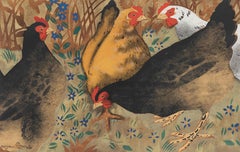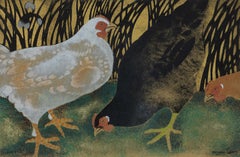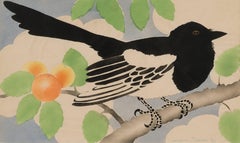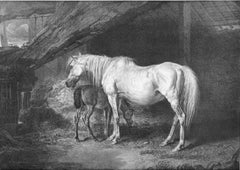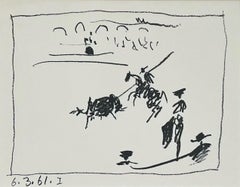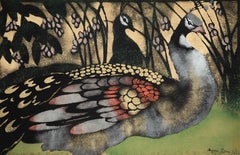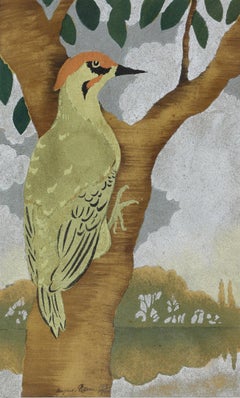Stencil Animal Prints
to
1
2
Overall Width
to
Overall Height
to
1
3
1
1
1
1
2
1
3
3
3
2
1
3
3
1
1
1
3
3
Artist: Georges Henri Manzana Pissarro
Medium: Stencil
Les poules by Georges Manzana Pissarro - Stencil
Located in London, GB
Les poules by Georges Manzana Pissarro (1871-19610
Pochoir
30 x 46 cm (11 ³/₄ x 18 ¹/₈ inches)
Signed with Estate stamp Manzana Pissarro and numbered 7/100 lower left
Artist biograp...
Category
20th Century Stencil Animal Prints
Materials
Stencil
Three Hens by Georges Manzana Pissarro - Animal stencil
Located in London, GB
Three Hens by Georges Manzana Pissarro (1871-1961)
Pochoir
31.8 x 48.3 cm (12 ½ x 19 inches)
Signed with Estate stamp and épreuve d'état
Provenance
Private Collection, London
Artis...
Category
19th Century Post-Impressionist Stencil Animal Prints
Materials
Stencil
Magpie by Georges Manzana Pissarro - Stencil art, Animal
Located in London, GB
Magpie by Georges Manzana Pissarro (1871-1961)
Pochoir
26.5 x 45 cm (10 ³/₈ x 17 ³/₄ inches)
Signed lower right manzana - Pissarro and numbered 2/100
Artist biograpraphy:
Like all s...
Category
1920s Stencil Animal Prints
Materials
Stencil
Related Items
Primrose and Foal: A Brood-Mare, late the Property of his Grace the Duke of Graf
By James Ward
Located in Boston, MA
From Celebrated Horses, Grundy 24. A fine chine applique impression in fine condition with full margins. A proof before letters. Exhibited at the...
Category
19th Century Romantic Stencil Animal Prints
Materials
Lithograph
$3,500
H 13.25 in W 17.75 in
La Pique (I), from A Los Toros Avec Picasso
Located in Washington, DC
Artist: Pablo Picasso
Title: La Pique (I)
Portfolio: A Los Toros Avec Picasso
Medium: Transfer lithograph
Date: 1961
Frame Size: 17 1/4" x 19 3/4"
Sheet Size: 9 1/2" x 12 1/2"
Image ...
Category
1960s Abstract Stencil Animal Prints
Materials
Lithograph
Presse Ludovico Mirri Mercante d’Quadri incontro al Palazzo Bernini a Roma No.46
Located in Paonia, CO
Presse Ludovico Mirri Mercante d’Quadri incontro al Palazzo Bernini a Roma No.46 is from a series of original engravings published by Lodovico Mirri in the late 18th century and engr...
Category
Late 18th Century Stencil Animal Prints
Materials
Engraving
Lioness i- Etching by Evert Louis van Muyden - 1900
Located in Roma, IT
Lioness is a modern artwork realized by Evert Louis van Muyden (Albano, Lazio 1853 - 1922 Orsay) in 1900 .
Black and white etching.
Signature and date on plate.
Includes passe-pa...
Category
Early 1900s Modern Stencil Animal Prints
Materials
Etching
$541
H 7.09 in W 10.24 in D 0.04 in
The Old Professor (Oo La La) Jim Dine lithograph and Ron Padgett poetry
By Jim Dine
Located in New York, NY
Bright orange leaps up like flames, or swaying grass, over which hovers a large-eyed bee sketched in black and orange. Over the fire-red in neat handwriting Ron Padgett...
Category
1970s Pop Art Stencil Animal Prints
Materials
Lithograph
$1,500
H 17 in W 27.5 in
Original Italian Emidio di Nola Italian Macaroni original vintage food poster
Located in Spokane, WA
Emidio di Nola, original Italian pasta poster. Size 19" x 25.5". Professional acid-free archival linen-backed; in excellent condition; ready to frame....
Category
1950s Aesthetic Movement Stencil Animal Prints
Materials
Lithograph
$750
H 25.5 in W 19 in D 0.05 in
The Protectress
Located in San Francisco, CA
This artwork titled "The protectress" 1997 is a original stone cut with stencil on thin paper by noted Canadian Inuit artist Kakulu Saggiaktok, 1940-...
Category
Late 20th Century Other Art Style Stencil Animal Prints
Materials
Stencil
CRISALIDA
Located in Aventura, FL
Hand signed, titled, dated, and numbered in pencil by the artist. Edition of 100. Frame size: 40 x 32.75 inches. Artwork is in excellent condition. Certificate of authenticity inc...
Category
1980s Contemporary Stencil Animal Prints
Materials
Lithograph, Paper
"Lion Tamer" framed signed lithograph by Alexander Calder. Edition EA of 100.
Located in Boca Raton, FL
"Lion Tamer" lithograph by Alexander Calder. Hand-lettered EA in lower left front corner. Hand-signed Calder in lower right front corner. From an ed...
Category
1970s Modern Stencil Animal Prints
Materials
Lithograph
$12,000
H 31 in W 39.25 in
Horses in a Mythological Landscape - Lithograph
Located in Paris, IDF
Giorgio de CHIRICO
Horses in a Mythological Landscape, c. 1955
Lithograph and stencil (Jacomet workshop)
Printed signature in the plate
On light vellum 48 x 38 cm (c. 19 x 15 in)
V...
Category
1950s Surrealist Stencil Animal Prints
Materials
Lithograph, Stencil
$1,156 Sale Price
20% Off
H 18.9 in W 14.97 in
Birds - XXI century, Figurative print, Black and white, Animals
By Anna Mikke
Located in Warsaw, PL
Limited edition, 8/10. ANNA MIKKE (born in 1950) She graduated from the Academy of Fine Arts in Łódź in 1975. After graduation, she was engaged in graphic design, including designing...
Category
2010s Other Art Style Stencil Animal Prints
Materials
Paper, Etching
$180
H 4.73 in W 10.04 in
"Magic Circus" framed lithograph by Michel Delacroix hand signed and numbered
Located in Boca Raton, FL
"Magic Circus" lithograph by Michel Delacroix. Hand-signed MIchel Delacroix. Hand-numbered XX/C. Depicts a circus, complete with elephant and horses, traveling through a French city...
Category
20th Century Other Art Style Stencil Animal Prints
Materials
Lithograph
Previously Available Items
Peacocks by Georges Manzana Pissarro - Animal pochoir
Located in London, GB
Peacocks by Georges Manzana Pissarro (1871-1961)
Pochoir
31.3 x 49.5 cm (12 ³/₈ x 19 ¹/₂ inches)
Signed with Estate stamp Manzana Pissarro and numbered 45/100 lower right
Provenance...
Category
1920s Stencil Animal Prints
Materials
Stencil
The Green Woodpecker by Georges Manzana Pissarro - Animal stencil
Located in London, GB
*UK BUYERS WILL PAY AN ADDITIONAL 20% VAT ON TOP OF THE ABOVE PRICE
The Green Woodpecker by Georges Manzana Pissarro (1871-1961)
Pochoir
31 x 47 cm (12 ¹/₄ x 18 ¹/₂ inches)
Signed w...
Category
1920s Post-Impressionist Stencil Animal Prints
Materials
Stencil
Peacock by Georges Manzana Pissarro - Animal pochoir, 20th century
Located in London, GB
Peacock by Georges Manzana Pissarro (1871-1961)
Pochoir
32 x 48 cm (12 ⁵/₈ x 18 ⁷/₈ inches)
Signed with the artist's stamp lower right, manzana. Pissarro.
Artist biography
Like all ...
Category
1920s Art Deco Stencil Animal Prints
Materials
Stencil
Magpie by Georges Henri Manzana Pissarro - Pochoir
Located in London, GB
*UK BUYERS WILL PAY AN ADDITIONAL 20% VAT ON TOP OF THE ABOVE PRICE
Magpie by Georges Henri Manzana Pissarro (1871-1961)
Pochoir
26.4 x 43.5 cm (10 ³/₈ x 17 ¹/₈ inches)
Signed Manza...
Category
20th Century Art Deco Stencil Animal Prints
Materials
Stencil
Stencil animal prints for sale on 1stDibs.
Find a wide variety of authentic Stencil animal prints available on 1stDibs. While artists have worked in this medium across a range of time periods, art made with this material during the 21st Century is especially popular. If you’re looking to add animal prints created with this material to introduce a provocative pop of color and texture to an otherwise neutral space in your home, the works available on 1stDibs include elements of blue and other colors. There are many well-known artists whose body of work includes ceramic sculptures. Popular artists on 1stDibs associated with pieces like this include Salvador Dalí, Georges Henri Manzana Pissarro, Banksy, and (after) Max Ernst. Frequently made by artists working in the Surrealist, Post-Impressionist, all of these pieces for sale are unique and many will draw the attention of guests in your home. Not every interior allows for large Stencil animal prints, so small editions measuring 0.5 inches across are also available
Recently Viewed
View AllMore Ways To Browse
Manetti Saverio
Natural History Museum Vintage Prints
Penguin Lithograph
Peter Klucik
Pheasant Engraving
Picasso Dove Of Peace
Picasso Le Taureau
Picasso Rooster
Ronald Smith
Rooster Print Picasso
Salvador Dali Argus
Salvador Dali Unicorn
Sam Savitt
Shore Bird Print
Space Elephant Dali
Szabolcs Bozo
The Toad Picasso
Vintage Forest Service Posters
